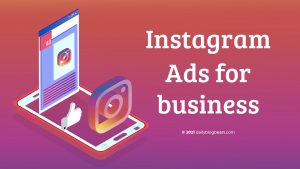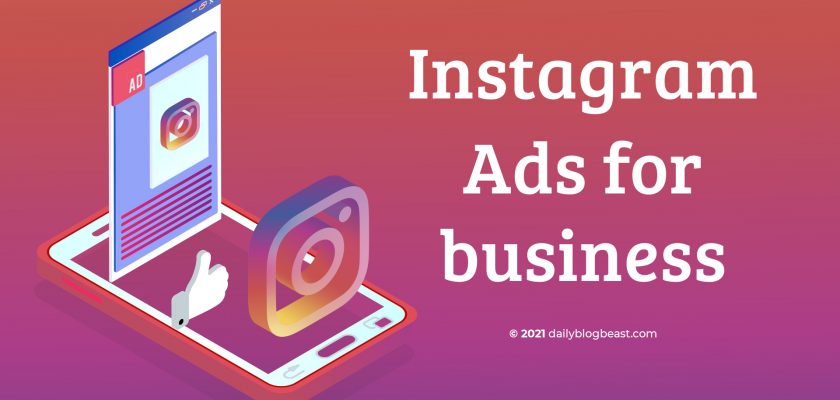If you’re searching for new methods to improve your Instagram approach, consider using Instagram advertising in your strategy. While this strategy necessitates some investment, there are several reasons for businesses to give it a shot.
Every month, over 1 billion people(active user) use Instagram, with the average user spending 53 minutes per day looking around the platform, and you want your business to be visible to them.

We’ve got you covered with this tutorial, whether you’re new to Instagram marketing for your business in general or just getting started with Instagram advertisements. Following its acquisition by Facebook in 2013, Instagram began providing ad spaces to select companies. It expanded quickly once they extended Instagram advertising to all businesses in 2015, and by 2017 it had surpassed 1 million advertisers.
Instagram advertising is controlled directly within Facebook’s Advertisements Manager, offering marketers a wide range of targeting options and the ability to develop ads for both networks at the same time. Advertisements that display in your audience’s feed as well as Story ads that play in between user Stories when users tap from Story to Story are available for Instagram-only ads. Organic social media tactics may appear to be cost-effective at first glance, but they take time, need a lot of test and mistakes, and may only get you so far when dealing with constantly changing social media algorithms.
This is why focusing on a social media plan that includes both organic and paid approaches is critical. This way you will get the best of both world. You’re actively connecting with your audience and publishing content to your Instagram feed, but you’re also using sponsored advertisements to reach out to an even broader audience who may not yet be aware of your business.
The cost of Instagram advertising is determined by a number of criteria, including the mobile device you’re targeting, demographics, the day of the week, and if your ad is running during a major televised event. Everything goes back to your target group, which is why knowing your Instagram demographics is so crucial.
The ad’s placement is another aspect that influences ad pricing. While Facebook’s right column advertising are the most costly, Instagram feed and Story advertisements are among the most affordable, with CPCs ranging from $0.80 to $1.30. So, how can you work this into your existing marketing budget? It’s critical to stay focused on your year’s main goals and objectives, and only spend money on advertisements and initiatives that benefit your bottom line. Spend money on pieces and content that you know perform well organically. Test everything to find what works best, then devote the majority of your ad budget to it.
Make a point of measuring your ad’s success and noting everything that didn’t go as planned. As previously stated, you may create Instagram advertisements directly from the Facebook advertising management. This makes it simple because you can manage both your Facebook and Instagram advertisements in one location.
Log into your own Facebook account, go to your advertising manager, and create a new campaign to begin crafting your first Instagram ad. After you’ve created a new campaign, the first step in producing Instagram advertisements is to decide on the goal of your ad. You may choose from several alternatives that are grouped into three different groups: awareness, consideration, and conversion.
There are a variety of ad kinds to select from, including: Brand awareness: This is a great way to target consumers who will interact with your ad and raise brand awareness. Brands who want to get their advertising in front of as many people as possible should choose this option. A traffic objective is ideal if you want people to visit your website, landing page, or app. Engagement: If you want people to enjoy, comment on, or share your ad, you should make engagement your goal.
Brands sending consumers to the app store to download or purchase apps should aim towards this purpose. In-stream commercials feature production, product debuts, and behind-the-scenes video to visually attract people to watch. Lead generation: Are you only looking for folks that are interested in or intrigued about your brand? Set a target for generating leads. Messages: This encourages consumers to connect with your business in order to get answers to product queries, get help, or make purchases.
Conversions: This objective is perfect if you’re aiming for direct sales activities on your advertising, such as inputting payment information or making a purchase. Catalog sales: This format is for companies to display items from their product catalogues (which must be set up in order to utilise this format), which then target their audience. Store traffic: This is ideal for businesses marketing numerous locations in order to increase in-store visitors. Make an informed resolution while deciding on a goal.
Your ad will most likely be rejected if you select a goal that doesn’t make sense, such as generating a traffic ad for a video or a messages ad for an Instagram placement. Furthermore, you don’t want to squander your ad spend by selecting a goal that isn’t relevant to the material you’re promoting. After you’ve chosen your ad objective, the screen will expand so you can give your campaign a name. Because this is the most effective approach to keep track of your advertisements in the Instagram ads manager, I strongly advise you to name each campaign with care.

